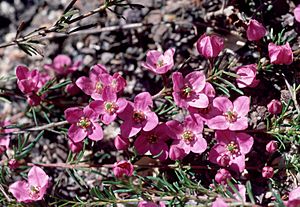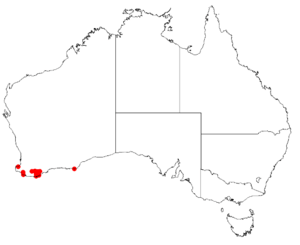Pink boronia facts for kids
Quick facts for kids Pink boronia |
|
|---|---|
 |
|
| Boronia pulchella in the Australian National Botanic Gardens | |
| Scientific classification | |
 |
|
| Occurrence data from Australasian Virtual Herbarium |
The Boronia pulchella, also known as the pink boronia, is a special plant. It belongs to the citrus family, called Rutaceae. This plant is found only in a small area in the south-west of Western Australia. It is a thin shrub with stems that look like rods. It has pinnate leaves and pretty deep pink flowers with four petals.
Contents
What the Pink Boronia Looks Like
The pink boronia is a thin shrub. Its stems look like rods and are covered with short, soft hairs. This plant can grow to about 1 m (3.3 ft) tall.
Its leaves are compound, meaning they are made up of smaller parts. Each leaf has an odd number of these smaller parts, usually between three and fifteen. The leaves are smooth and hairless (this is called glabrous). They are long and narrow, about 5–12 mm (0.20–0.47 in) in length.
The flowers are a deep pink color. They grow one by one where a leaf meets the stem (this spot is called a leaf axil). Each flower sits on a small stalk, or pedicel, which is about 6–10 mm (0.24–0.39 in) long.
Each flower has four sepals. Sepals are small leaf-like parts that protect the flower bud. These sepals are narrow and triangular, about 2 mm (0.08 in) long and have no hairs. The four petals are egg-shaped and about 6–9 mm (0.2–0.4 in) long. They have a few soft hairs on them.
Inside the flower, there are ten stamens. Stamens are the parts that produce pollen. These stamens have a few soft hairs. The ones closest to the sepals have a noticeable bump on top. The stigma, which is the part that receives pollen, is round and about 1 mm (0.04 in) across. Pink boronia flowers bloom from September to November.
How Pink Boronia Got Its Name
The Boronia pulchella was first officially described in 1852. A scientist named Nikolai Turczaninow wrote about it. His description was published in a science paper called Bulletin de la Société Impériale des Naturalistes de Moscou.
The second part of its scientific name, pulchella, comes from a Latin word. Pulcher means "pretty." So, pulchella means "pretty little." This name perfectly describes the plant's delicate beauty.
Where Pink Boronia Lives
Pink boronia grows in special places in Western Australia. It likes stony and sandy soils. You can find it on rock outcrops, in small valleys (gullies), and along water paths. It mostly grows in the Esperance Plains biogeographic region. This is an area known for its unique plants. You can see it especially in the Stirling and Porongorup Ranges.
Protecting the Pink Boronia
The Western Australian Government's Department of Parks and Wildlife keeps track of plants and animals. They have looked at the pink boronia. They say it is "not threatened." This means there are enough of these plants, and they are not currently in danger of disappearing.

